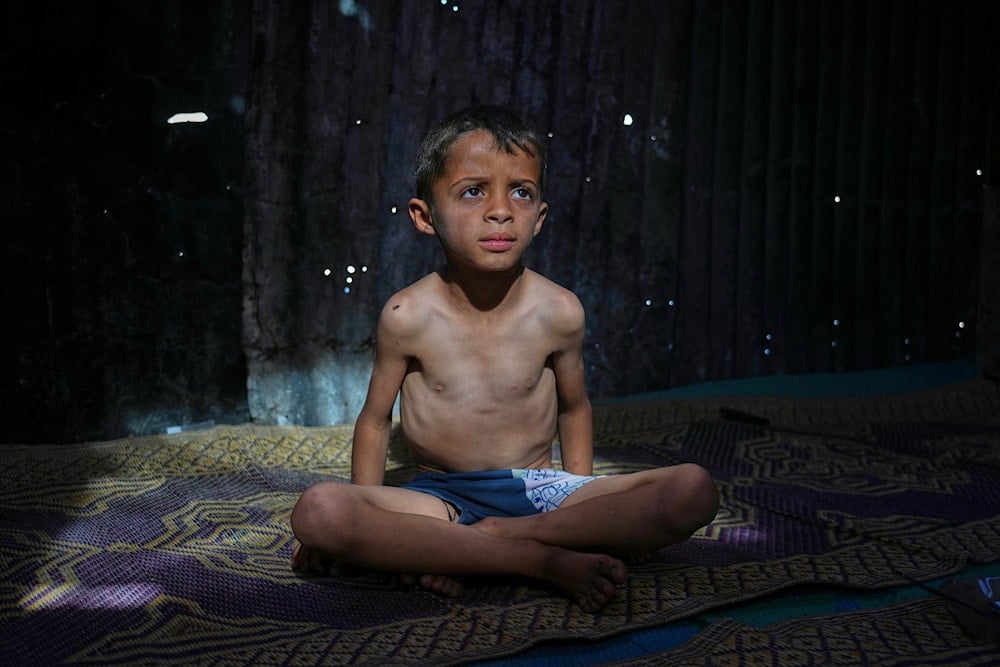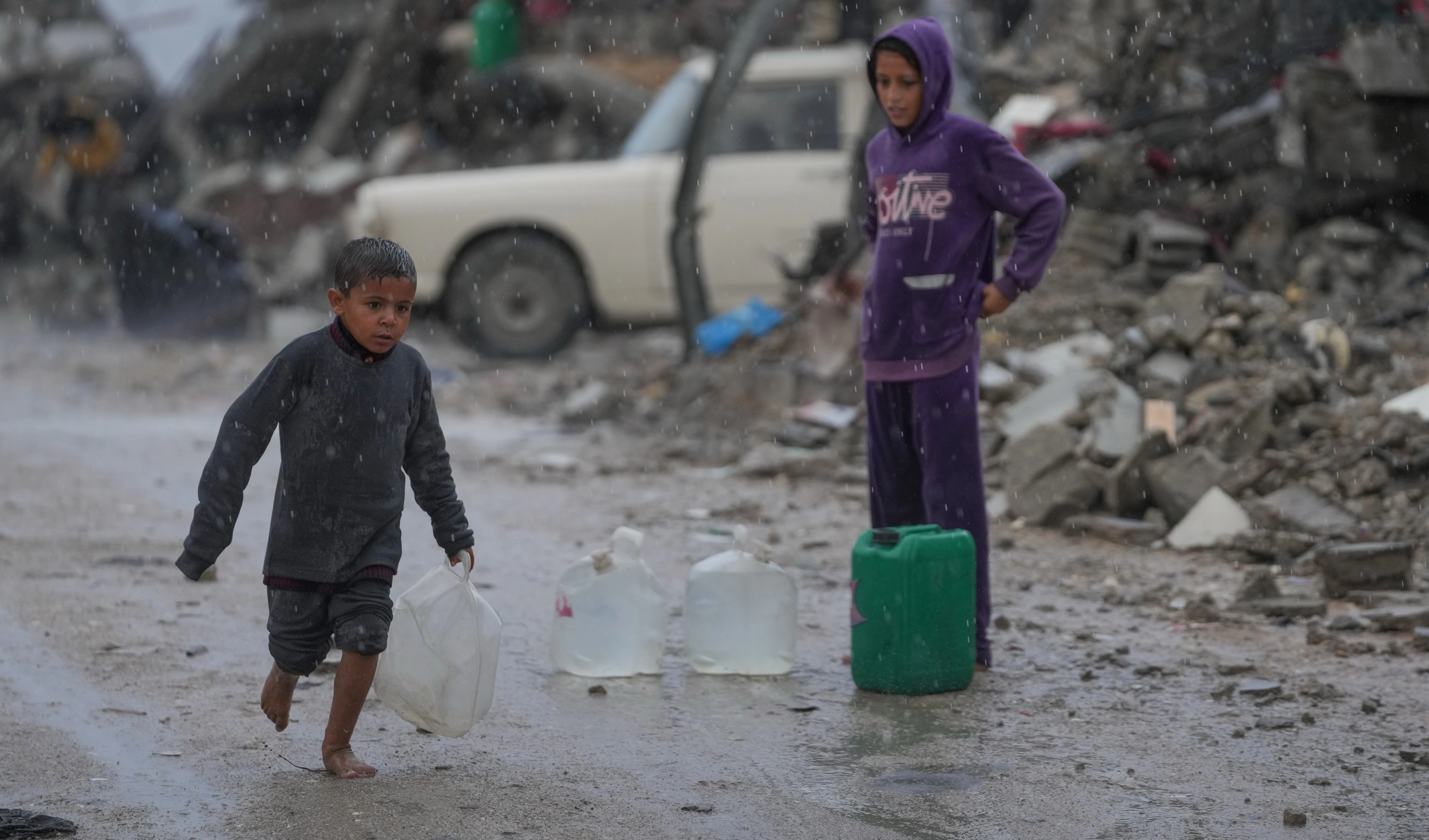Child malnutrition in Gaza surges amid prolonged starvation: AP
As "Israel’s" blockade on Gaza enters its third month, child malnutrition rates are soaring.
-

Ahmed El-Sheikh Eid, 7, who shows signs of malnutrition, poses for a photo at his family tent at a camp for displaced Palestinians in Mawasi Khan Younis, Gaza Strip, on May 2, 2025. (AP Photo/Abdel Kareem Hana)
A report published by the Associated Press (AP) on Sunday covered the cases of malnourished children in the besieged enclave. The first case discusses the devastating situation of little Khaled, who was in tears and showing signs of distress. He was suffering from diarrhea and dehydration. At 9 months, he weighs barely 5 kilos, half the weight of a healthy baby his age.
The report detailed that after repeated emergency visits, doctors admitted Khaled last weekend. For nearly a week, he received tube feeding, then supplements and bottled milk, which is distributed every few hours.
“I wish they would give it to us every hour. He waits for it impatiently ... but they too are short on supplies,” his mother, Wedad Abdelaal, says. “This border closure is destroying us.”
As "Israel’s" blockade of Gaza enters its third month, the longest since the war began, starvation grips the Strip. Thousands of children have been treated for malnutrition, while parents like Abdelaal remain displaced and exhausted, watching their children waste away with no options left.
Gaza’s hospitals crumble under blockade
The AP report mentions that hospitals are dealing with mass casualty incidents and lacking basic supplies; food stocks at UN warehouses have been depleted, and local markets are emptying. What remains is unaffordable in a region where, according to the United Nations, over 80% of the population depends on aid.
Community kitchens are shutting down, farmland is inaccessible, bakeries are closed, and water distribution is grinding to a halt, mostly due to fuel shortages. Additionally, thousands, many of them children, crowd outside the remaining kitchens, desperately seeking food.
Despite international outcry, "Israel" has not lifted the blockade. More humanitarian groups now accuse it of using starvation as a weapon of war, and acute child malnutrition is spiraling.
“We are breaking the bodies and minds of the children of Gaza,” said Michael Ryan, executive director of emergencies at the World Health Organization, adding, “Because if we don’t do something about it, we are complicit in what is happening before our very eyes. ... The children should not have to pay the price.”
Starvation as a weapon: the toll on Gaza’s children
The blockade was imposed by "Israel" on March 2, and on March 18, it ended a two-month ceasefire, resuming military operations.
Moreover, while "Israel" insists that aid had surged during the ceasefire, humanitarian workers deny that there was significant diversion of supplies, asserting that UN monitoring is strict.
Khaled has suffered from malnutrition since he was two months old, initially treated through outpatient care and feeding centers, but his condition worsened over seven months. Also, his mother, also malnourished, struggles to breastfeed.
Displaced from Rafah, the family lives in a tent in Mawasi Khan Younis. With food supplies cut off by the blockade, they rely on community kitchens for basic staples. Cooking has become increasingly difficult without gas, and gathering wood or plastic to burn is risky and unsafe.
Malnutrition crisis: Numbers reveal the catastrophe
Since March 2, UN agencies have reported a sharp rise in acute malnutrition across Gaza. Children are increasingly showing signs such as low immunity, frequent illness, and severe weight loss. UNICEF has treated over 9,000 children for acute malnutrition since the start of the year, including 3,600 cases in March alone—an 80% increase from February.
Supplies of supplements and therapeutic food are rapidly dwindling. With resources stretched, some parents have begun sharing treatments between children, reducing their effectiveness.
Nearly half of Gaza’s 200 nutrition centers have shut down due to displacement and bombardment. Meanwhile, aid remains stuck at the borders, blocked by "Israel."
“It is absolutely clear that we are going to have more cases of wasting, which is the most dangerous form of malnutrition,” warns UNICEF spokesperson Jonathan Crickx.
Parents increasingly turn to feeding centers, but these too are overwhelmed.
Collapse of community support, health systems
At Nasser Hospital, only the most critical malnutrition cases are admitted due to limited capacity. Dr. Yasser Abu Ghaly says, “If we admit all those who have acute malnutrition, we will need hundreds of beds ... There is nothing in our hands.”
Before the war, many children were being treated for congenital or genetic disorders, but that system has now collapsed. Dr. Ahmed al-Farrah warns that hundreds of children with genetic conditions may now suffer cognitive damage or worse.
Children like Osama al-Raqab, who has cystic fibrosis, are deteriorating rapidly due to the lack of medicine and protein-rich food. “With starvation in Gaza, we only eat canned lentils,” his mother says.
Additionally, Sama, a baby with Down syndrome, has gained only 300 grams in seven months. Her mother, malnourished and ill, cannot produce enough milk. “I can’t believe this is the leg of a 7-month-old,” she says.
At home, Abdelaal’s children fetch water and queue at soup kitchens. When they return, the family divides the food over several days. When there is none, they share canned beans. Her husband, Ammar, has a heart condition and cannot help.
Prices are unaffordable: a kilo of potatoes costs $21, biscuits cost $2, and canned sardines nearly $10.

 5 Min Read
5 Min Read










